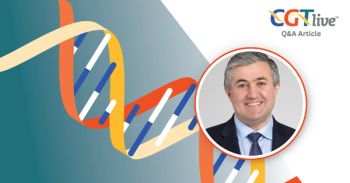
Canavan Disease Gene Therapy BBP-812 Shows Preliminary Efficacy and Safety
The findings, presented at ASGCT’s 2023 conference, included an analysis of biomarker data in relation to disease severity.
BridgeBio Pharma’s BBP-812, an investigational adeno-associated virus serotype 9 (AAV9) vector-based gene therapy intended to treat Canavan disease, was shown to positively impact biomarkers in data from the phase 1/2 CANaspire clinical trial (NCT04998396). The findings, along with additional preliminary efficacy and safety results, were presented orally in a session entitled “Gene and Cell Therapy Trials in Progress” at
The study assessed levels of N-acetylaspartate (NAA), which is present in abnormally high levels in patients with Canavan disease because of a loss-of-function mutation in ASPA, the gene that encodes the enzyme responsible for breaking down NAA. The study specifically evaluated NAA levels in the urine, cerebrospinal fluid (CSF), and brain. Florian Eichler, MD, a neurologist at Massachusetts General Hospital, who presented the data, noted that all 6 patients who have been treated in CANaspire so far experienced a rapid and persistent decline in urine NAA levels following administration of the gene therapy. Reductions in NAA levels in the CSF and brain were also observed. In addition to the biomarker data, there were also improvements observed in 4 patients in myelination on MRI and in Gross Motor Function Measure-88 (GMFM-88) score.
“These 4 patients show improvements in GMFM-88, particularly in sitting ability and head control,” Eichler said. “All of our patients show improvements in initiating voluntary head movements. There is 1 patient in particular who has been able to sit up and also to take a stand and take steps.”
Eichler also presented data from a natural history study, CANinform (NCT04126005), which is running in parallel to CANaspire. CANinform has enrolled 55 patients with Canavan disease from 14 countries so far. The purpose of the study is to build a comparator group for CANaspire and inform the selection of end points. Eichler pointed out that there are currently no validated scales for Canavan disease, but that the data from the natural history study is intended to allow for examination of the relationship between NAA levels and disease severity.
Based on a collation of CANinform data, pretreatment data from CANaspire, and data from literature review, it was determined that urine NAA is lower in the mild phenotype of Canavan disease than in the typical phenotype. Patients are considered to have the mild phenotype if they are able to pull to stand; patients with the mild phenotype made up approximately 10% of the CANinform population. All 6 patients enrolled in CANaspire showed urine NAA levels in the typical range for Canavan disease prior to treatment with BBP-812; after treatment, all of the patients experienced a reduction in urine NAA levels to the mild range.
In terms of safety, 3 patients dosed with BBP-812 experienced serious treatment-emergent adverse events (AEs). These AEs include severe subdural hemorrhage, severe seizure, severe gastrostomy, severe vomiting, and moderate decerebrate posture. The gastrostomy was not related to BBP-812 and the subdural hemorrhage, seizure, and vomiting were deemed unlikely to be related to BBP-812. The decerebrate posture was deemed possibly related to BBP-812. Eichler noted that laboratory findings were expected and manageable.
All 6 patients received a dose of 1.32x1014 vg/kg of BBP-812. The patients were required to be aged 30 months or younger at dosing and to be AAV9 total anti-body negative. Follow-up as of the March 25, 2023, data cutoff ranges from less than 1 month to 17 months.
“[BBP-812] has been generally well-tolerated...,” Eichler concluded. “Preliminary data on imaging and motor function are encouraging, but certainly we need more data and longer follow-up to fully characterize the potential clinical benefit.” In response to an audience question regarding the NAA measurements, Eichler additionally acknowledged that there were limitations in the methods used to gather and collate the biomarker data.
REFERENCE
Eichler F, Nagy A, Laforet G, et al. Initial biomarker and clinical findings from the CANaspire Canavan disease gene therapy trial: Exploration of connections between NAA and disease severity. Presented at: American Society of Gene and Cell Therapy (ASGCT) 2023 Annual Meeting. May 16-20, 2023; Los Angeles, CA. Abstract #358.
Newsletter
Stay at the forefront of cutting-edge science with CGT—your direct line to expert insights, breakthrough data, and real-time coverage of the latest advancements in cell and gene therapy.
















































